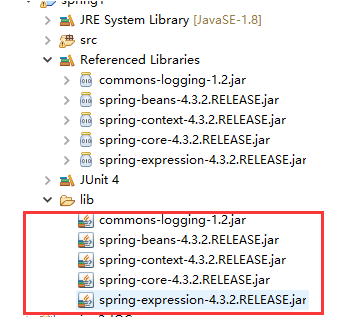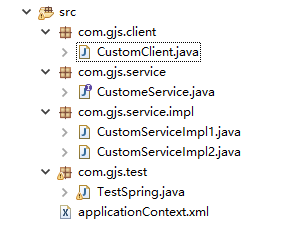1.Spring是什么?
Spring是一个JavaEE轻量级的一站式开发框架。
JavaEE: 就是用于开发B/S的程序。(企业级)
轻量级:使用最少代码启动框架,然后根据你的需求选择,选择你喜欢的模块使用。
重量级:早期有的EJB,开发一个HelloWorld程序都需要引入EBJ的全部模块
一站式:Spring框架提供涵盖了JavaEE开发的表示层,服务层,持久层的所有组件功能。也就是说,原则上,学完一套Spring框架,不用其他框架就可以完成网站一条流程的开发。但是Spring仍然可以和其他的框架无缝整合。
2.Spring的优点
轻量:Spring 是轻量的,就是除内核模块(4个jar),其他模块由开发者自由选择使用,同时支持整合其他框架。也可以称为就是可插拔式开发框架,像插头和插座一样,插上就用。这就是Spring框架核心理念(Ioc)。
控制反转:Spring通过控制反转实现了松散耦合,对象们给出它们的依赖,而不是创建或查找依赖的对象们。
面向切面的编程(AOP):Spring支持面向切面的编程,并且把应用业务逻辑和系统服务分开。
容器:Spring 包含并管理应用中对象的生命周期和配置。
MVC框架:Spring的WEB框架是个精心设计的框架,是Web框架的一个很好的替代品。
事务管理:Spring 提供一个持续的事务管理接口,可以扩展到上至本地事务下至全局事务(JTA)。
异常处理:Spring 提供方便的API把具体技术相关的异常(比如由JDBC,Hibernate or JDO抛出的)转化为一致的unchecked 异常。
3.Spring的作用
Spring强调的理念是,轻量级。Spring的轻量级主要体现在模块的可插拔,Spring提供的功能模块,除了内核模块以外,开发人员可以选择性使用。所以,Spring框架在现实开发中,主要的功能用于整合各种开发框架开发项目。
4.Spring框架包
Spring官方网站:https://spring.io/
4.1 下载
Spring官方提供的Maven方式的项目下载:https://start.spring.io/
但是基于简单入门的原则,我们要通过导入包的方式来学习。需要下载框架的zip包
地址为:http://repo.springsource.org/libs-release-local/org/springframework/spring/
4.2 目录说明
根目录:

jar包:

包说明:
| 包名 | 说明 |
| spring-aop-4.3.2.RELEASE.jar | 实现了AOP的支持 |
| spring-aspects-4.3.2.RELEASE.jar | AOP框架aspects支持包 |
| spring-beans-4.3.2.RELEASE.jar | 内核支撑包,实现了处理基于xml对象存取 |
| spring-context-4.3.2.RELEASE.jar | 内核支撑包,实现了Spring对象容器 |
| spring-context-support-4.3.2.RELEASE.jar | 容器操作扩展包,扩展了一些常用的容器对象的设置功能 |
| spring-core-4.3.2.RELEASE.jar | 内核支撑包,Spring的内核 |
| spring-expression-4.3.2.RELEASE.jar | 内核支撑包,实现了xml对Spring表达式的支持 |
| spring-instrument-4.3.2.RELEASE.jar | 提供了一些类加载的的工具类 |
| spring-instrument-tomcat-4.3.2.RELEASE.jar | 提供了一些tomcat类加载的的工具类,实现对应Tomcat服务的调用 |
| spring-jdbc-4.3.2.RELEASE.jar | SpringJDBC实现包,一个操作数据库持久层的子框架 |
| spring-jms-4.3.2.RELEASE.jar | 集成jms的支持,jms:Java消息服务。 |
| spring-messaging-4.3.2.RELEASE.jar | 集成messaging api和消息协议提供支持 |
| spring-orm-4.3.2.RELEASE.jar | ORM框架集成包,实现了Hibernate,IBatis,JDO的集成。 |
| spring-oxm-4.3.2.RELEASE.jar | Spring OXM对主流O/X Mapping框架做了一个统一的抽象和封装。就是对应XML读写框架的支持 |
| spring-test-4.3.2.RELEASE.jar | Spring集成JUnit测试 |
| spring-tx-4.3.2.RELEASE.jar | 事务代理的支持 |
| spring-web-4.3.2.RELEASE.jar | SpringWeb通用模块 |
| spring-webmvc-4.3.2.RELEASE.jar | SpringMVC子框架 |
| spring-webmvc-portlet-4.3.2.RELEASE.jar | Spring对门户技术(portlet)的支持 |
| spring-websocket-4.3.2.RELEASE.jar | Spring对websocket的支持 |
注:红色部分为基础核心包,使用Spring必须导入
5.入门实例
Spring之所以可以实现模块的可插拔是支持依赖注入,所谓的依赖注入/控制反转就是不用new就可以创建对象。
使用Spring框架不用new创建一个对象:
1.创建项目并导入jar包:将Spring的基础支撑包和依赖的日志包复制到lib文件下,并且加入项目中

2.创建配置文件
在项目的src下面创建配置文件applicationContext.xml中并完成配置文件的约束
<?xml version="1.0" encoding="UTF-8"?> <beans xmlns="http://www.springframework.org/schema/beans" xmlns:xsi="http://www.w3.org/2001/XMLSchema-instance" xsi:schemaLocation="http://www.springframework.org/schema/beans http://www.springframework.org/schema/beans/spring-beans.xsd"> </beans>
3.创建对象到Spring容器中
创建一个类
package com.gjs.service; public class HelloSpringService { public void say() { System.out.println("你好!Spring"); } }
往applicationContext.xml配置文件中加入配置
<?xml version="1.0" encoding="UTF-8"?> <beans xmlns="http://www.springframework.org/schema/beans" xmlns:xsi="http://www.w3.org/2001/XMLSchema-instance" xsi:schemaLocation="http://www.springframework.org/schema/beans http://www.springframework.org/schema/beans/spring-beans.xsd"> <!-- <bean id="" class = ""> 配置让spring管理类的对象的创建 id : 唯一标识 class :被管理类的全限定名 --> <bean id="HelloSpringService" class="com.gjs.service.HelloSpringService"/> </beans>
测试类, 使用getBean方法获得容器中的对象。
package com.gjs.test; import static org.junit.Assert.*; import org.junit.Test; import org.springframework.context.ApplicationContext; import org.springframework.context.support.ClassPathXmlApplicationContext; import com.gjs.service.HelloSpringService; public class TestSpring { @Test public void testName() throws Exception { ApplicationContext context = new ClassPathXmlApplicationContext("applicationContext.xml"); HelloSpringService helloSpringService = context.getBean("HelloSpringService",HelloSpringService.class); helloSpringService.say(); } }
6.Spring容器的两个实现
ClassPathXmlApplicationContext:通过classpath路径(相对路径)直接获得加载的xml文件(推荐使用)
ApplicationContext context = new ClassPathXmlApplicationContext("applicationContext.xml");
FileSystemXmlApplicationContext:通过文件路径(绝对路径)来获得加载的xml文件。
ApplicationContext context = new FileSystemXmlApplicationContext("D:\java\eclipse-workspace\spring1\src\applicationContext.xml");
8.控制反转(IOC)和依赖注入(DI)(A)
DI:Dependency Injection(依赖注入):
依赖注入是指Spring创建对象的过程中,将对象依赖属性(简单值,集合,对象)通过配置设值给该对象。
IoC:Inverse of Control(控制反转):
Spring号称是一个可以实现模块可插拔的JavaEE开发框架。而实现程序可插拔的核心理念就是控制反转。所谓的控制反转,就是将代码的调用权从调用方转移给被调用方(服务提供方)。不用修改调用方的的代码,只要修改配置文件就实现对象的切换。
读作“反转控制”,更好理解,它不是什么技术,而是一种设计思想,好比于MVC。就是将原本在程序中手动创建对象的控制权,交由Spring框架来管理。
正控:若调用者需要使用某个对象,其自身就得负责该对象的创建。
反控:调用者只管负责从Spring容器中获取需要使用的对象,不关心对象的创建过程,也就是把创建对象的控制权反转给了Spring框架。
控制反转(Ioc),就是依赖注入加上面向接口的编程思想的实现
示例:
整体结构:

CustomService接口:
package com.gjs.service; public interface CustomeService { public void say(); }
实现类CustomServiceImpl1:
package com.gjs.service.impl; import com.gjs.service.CustomeService; public class CustomServiceImpl1 implements CustomeService { @Override public void say() { System.out.println("CustomerServiceImpl1.say()"); } }
实现类CustomServiceImpl2:
package com.gjs.service.impl; import com.gjs.service.CustomeService; public class CustomServiceImpl2 implements CustomeService { @Override public void say() { System.out.println("CustomerServiceImpl2.say()"); } }
调用方 CustomClient:
package com.gjs.client; import com.gjs.service.CustomeService; public class CustomClient { //1.声明一个接口引用类型 private CustomeService customeService; //2.spring的依赖注入(DI)需要有一个set方法 public void setCustomeService(CustomeService customeService) { this.customeService = customeService; } public void say() { customeService.say(); } }
配置文件 applicationContext.xml:
<?xml version="1.0" encoding="UTF-8"?> <beans xmlns="http://www.springframework.org/schema/beans" xmlns:xsi="http://www.w3.org/2001/XMLSchema-instance" xsi:schemaLocation="http://www.springframework.org/schema/beans http://www.springframework.org/schema/beans/spring-beans.xsd"> <!-- <bean id="" class = ""> 配置让spring管理类的对象的创建 id : 唯一标识 class :被管理类的全限定名 --> <bean id="client" class="com.gjs.client.CustomClient"> <!-- 依赖注入(DI) :注入被调用方 <property name="" value/ref=""/> 位置: name : 是set方法确定的属性,不是成员变量 确定属性 : setXxx 方法去掉set前缀 ,剩余部分首字母小写 参数: value : 值类型注入(字符串,基本数据类型) ref :引用数据类型(对象), 对应bean的id --> <property name="customeService" ref="ServiceImpl1"/> </bean> <bean id="ServiceImpl1" class="com.gjs.service.impl.CustomServiceImpl1"/> <bean id="ServiceImpl2" class="com.gjs.service.impl.CustomServiceImpl2"/> </beans>
测试类:
package com.gjs.test; import static org.junit.Assert.*; import org.junit.Test; import org.springframework.context.ApplicationContext; import org.springframework.context.support.ClassPathXmlApplicationContext; import com.gjs.client.CustomClient; import com.gjs.service.CustomeService; public class TestSpring { @Test public void testName() throws Exception { //1.读取配置文件,创建Spring容器 ApplicationContext context = new ClassPathXmlApplicationContext("applicationContext.xml"); //获取调用方 CustomClient对象 CustomClient client = context.getBean("client", CustomClient.class); //调用CustomClient对象的say()方法 client.say(); } }
应用:
Spring框架又被称为容器框架,即通过控制反转将各个框架的对象创建交给Spring管理,然后通过依赖注入在层之间传递参数整合框架,并达到低耦合的目的。

9.标签说明
9.1 bean标签
作用:用于声明一个类,在启动Spring框架的时候根据该配置的类创建对象到容器里面
<bean id="someBean" class="com.gjs.pojo.SomeBean" scope="prototype"></bean>
id:设置对象名(唯一标识符)(推荐使用)
name:设置对象名(唯一标识符),与id的区别是可以有多个名称,每个名称用逗号隔开。
class:指定对象对应的类
scope:用于设置的对象的作用范围,可选参数如下:

在Web开发的三层架构中的使用
Web层:一般都是多例
Service层 :单例
DAO层 :单例
9.2 alias 别名标签
作用:为已配置的bean设置别名
bean id="user" name="test" class="com.gjs.pojo.User"/>
<alias name="user" alias="user1"/>
name:必要属性, 代表为哪一个bean配置别名, 此属性的值为其他bean标签的id或name属性值
alias: 必要属性,命名的别名
10.实例化Bean的四种方式
1.构造器实例化(无参数构造器):(最常用)
public class SomeBean { public SomeBean() { System.out.println("SomeBean.SomeBean()"); } }
<bean id="someBean" class="com.gjs.pojo.SomeBean"/>
2.通过静态方法工厂创建(C)
public class SomeBean { public SomeBean() { System.out.println("SomeBean.SomeBean()"); } } public class SomeBeanFacotry { //静态工厂方法 public static SomeBean getSomeBean() { System.out.println("执行静态工厂方法"); return new SomeBean(); } }
<bean id="someBean" class="com.gjs.pojo.SomeBeanFacotry" factory-method="getSomeBean"/>
3.通过实体工厂创建(C)
public class SomeBean { public SomeBean() { System.out.println("SomeBean.SomeBean()"); } } public class SomeBeanFacotry { //实例工厂方法 public SomeBean getSomeBean() { System.out.println("执行实例工厂方法"); return new SomeBean(); } }
<bean id="someBeanfactory" class="com.gjs.pojo.SomeBeanFactory"/>
或
<bean id="someBean" factory-bean="someBeanfactory" factory-method="getSomeBean"/>
4.实现FactoryBean接口实例化:实例工厂变种
实现FactoryBean接口,MyBatis和Spring集成就是使用的这种方式。此种方式,如果没有使用Bean对应的对象,Spring就不会自动创建,只有在使用的时候Spring才会创建对应的对象
public class SomeBean { public SomeBean() { System.out.println("SomeBean4.SomeBean4()"); } } public class SomeBeanObjectFactory implements FactoryBean<SomeBean>{ //返回的泛型类型对应的对象 @Override public SomeBean getObject() throws Exception { SomeBean bean = new SomeBean(); return bean; } }
<bean id="someBean" class="cn.zj.domian.SomeBeanObjectFactory"/>
11.初始化和销毁方法
<bean id="someBean" class="......"
<init-method="该类中初始化方法名"/>
<destroy-method="该类中销毁方法名"/>
</bean>
init-method:bean生命周期初始化方法,对象创建后就进行调用
destroy-method:容器被销毁的时候,如果bean被容器管理,会调用该方法。
12.依赖注入的四种方法
1.setter注入,(属性注入)(常用)
使用setter注入:
1,使用bean元素的<property>子元素设置;
1.简单类型值,直接使用value赋值;
2.引用类型,使用ref赋值;
3.集合类型,直接使用对应的集合类型元素即可。
2,spring通过属性的set方法注入值;
3,在配置文件中配置的值都是string,spring可以自动的完成类型的转换
示例:
员工类
public class Employee { private Integer age; private String name; private Department dept; public Integer getAge() { return age; } public void setAge(Integer age) { this.age = age; } public String getName() { return name; } public void setName(String name) { this.name = name; } public Department getDept() { return dept; } public void setDept(Department dept) { this.dept = dept; } @Override public String toString() { return "Employee [age=" + age + ", name=" + name + ", dept=" + dept + "]"; } }
部门类
public class Department { private Integer id; private String name; public Integer getId() { return id; } public void setId(Integer id) { this.id = id; } public String getName() { return name; } public void setName(String name) { this.name = name; } }
配置文件
<?xml version="1.0" encoding="UTF-8"?> <beans xmlns="http://www.springframework.org/schema/beans" xmlns:xsi="http://www.w3.org/2001/XMLSchema-instance" xsi:schemaLocation="http://www.springframework.org/schema/beans http://www.springframework.org/schema/beans/spring-beans.xsd"> <!-- 员工 --> <bean id="employee" class="com.gjs.pojo.Employee" > <!-- setter方法注入: 属性注入 <property name="" value=""> name : 属性名称 value : 基本数据类型+String类型的值注入 ref : 引用类型(对象类型)的注入 value 和ref 只能二选一 --> <property name="age" value="18"></property> <property name="name" value="张三"></property> <property name="dept" ref="dept"></property> </bean> <!-- 部门 --> <bean id="dept" class="com.gjs.pojo.Department" > <property name="id" value="1"/> <property name="name" value="开发部"/> </bean> </beans>
2.构造器注入
使用bean元素的<constructor-arg>子元素设置:
1.默认情况下,constructor-arg的顺序就是构造器参数的顺序
2. constructor-arg的属性
name : 构造方法参数的名称
index :参数的位置从 0 开始
value :值类型注入
ref :引用类型注入
type : 参数的数据类型
3.一般在一个类必须依赖另一个类才能正常运行时,才用构造器注入
<?xml version="1.0" encoding="UTF-8"?> <beans xmlns="http://www.springframework.org/schema/beans" xmlns:xsi="http://www.w3.org/2001/XMLSchema-instance" xsi:schemaLocation="http://www.springframework.org/schema/beans http://www.springframework.org/schema/beans/spring-beans.xsd"> <!-- 配置部门 --> <bean id="department" class="com.gjs.pojo.Department"> <constructor-arg name="id" value="2"/> <constructor-arg name="name" value="研发部"/> </bean> <!-- 配置员工 --> <bean id="emp" class="com.gjs.pojo.Employee"> <!-- 依赖注入 :构造器注入 --> <constructor-arg name="id" value="1"/> <constructor-arg name="name" value="张三"/> <constructor-arg name="dept" ref="department"/> </bean> </beans>
3.p命名空间注入
使用p命名空间注入先在约束上面引入 p标签
xmlns:p="http://www.springframework.org/schema/p"
<?xml version="1.0" encoding="UTF-8"?> <beans xmlns="http://www.springframework.org/schema/beans" xmlns:p="http://www.springframework.org/schema/p" xmlns:xsi="http://www.w3.org/2001/XMLSchema-instance" xsi:schemaLocation="http://www.springframework.org/schema/beans http://www.springframework.org/schema/beans/spring-beans.xsd"> <!-- 配置部门 --> <bean id="department" class="com.gjs.pojo.Department" p:id="3" p:name="销售部"/> <!-- 配置员工 --> <bean id="emp" class="com.gjs.pojo.Employee" p:id="1" p:name="张三" p:dept-ref="department"/> </beans>
4.集合类型值注入
用于处理:
1.键值对 Map 、Properties
2.数组
3.集合Set、List
public class CollectionBean { private Set<String> set; private List<String> list; private String[] array; private Map<String, String> map; private Properties prop; //读取本地 xxx.properties文件(本质就是一个Map集合) }
<?xml version="1.0" encoding="UTF-8"?> <beans xmlns="http://www.springframework.org/schema/beans" xmlns:xsi="http://www.w3.org/2001/XMLSchema-instance" xsi:schemaLocation="http://www.springframework.org/schema/beans http://www.springframework.org/schema/beans/spring-beans.xsd"> <bean id="collectionBean" class="cn.zj.spring.pojo.CollectionBean"> <!-- setter(属性)方法注入 --> <!-- 1.数组 --> <property name="arr"> <array> <value>AAA</value> <value>BBB</value> </array> </property> <!-- 2.set集合 --> <property name="set" > <set> <value>AAA</value> <value>AAA</value> <value>BBB</value> </set> </property> <!-- 3.list集合 --> <property name="lsit"> <list> <value>list1</value> <value>list1</value> <value>list2</value> </list> </property> <!-- 4. map集合 --> <property name="map"> <map> <entry key="key1" value="value1"/> <entry key="key2" value="value2"/> </map> </property> <!-- 5.properties 集合 --> <property name="prop"> <props> <prop key="propKey1">propValue1</prop> <prop key="propKey2">propValue2</prop> </props> </property> </bean> </beans>
13.获得properties文件的值
1.导入命名空间方法
将命名空间和约束重新拷贝一份,将对于的全部替换成 context,然后关联context本地schema约束
<?xml version="1.0" encoding="UTF-8"?> <beans xmlns="http://www.springframework.org/schema/beans" xmlns:p="http://www.springframework.org/schema/p" xmlns:context="http://www.springframework.org/schema/context" xmlns:xsi="http://www.w3.org/2001/XMLSchema-instance" xsi:schemaLocation="http://www.springframework.org/schema/beans http://www.springframework.org/schema/beans/spring-beans.xsd http://www.springframework.org/schema/context http://www.springframework.org/schema/context/spring-context.xsd "> </beans>
2.导入Mysql驱动包和druid连接池jar包

3.applicationContext.xml配置
<?xml version="1.0" encoding="UTF-8"?> <beans xmlns="http://www.springframework.org/schema/beans" xmlns:p="http://www.springframework.org/schema/p" xmlns:context="http://www.springframework.org/schema/context" xmlns:xsi="http://www.w3.org/2001/XMLSchema-instance" xsi:schemaLocation=" http://www.springframework.org/schema/beans http://www.springframework.org/schema/beans/spring-beans.xsd http://www.springframework.org/schema/context http://www.springframework.org/schema/context/spring-context.xsd "> <!-- 使用context 读取配置文件到spring容器中 <context:property-placeholder location=""/> location : db.properties文件的位置,必须加上 classpath: 作为前缀 --> <context:property-placeholder location="classpath:db.properties"/> <!-- 创建阿里巴巴druid连接池 --> <bean id="dataSource" class="com.alibaba.druid.pool.DruidDataSource" init-method="init" destroy-method="close" > <!-- 属性注入 setter方法注入--> <property name="driverClassName" value="${jdbc.driverClassName}"/> <property name="url" value="${jdbc.url}"/> <property name="username" value="${jdbc.username}"/> <property name="password" value="${jdbc.password}"/> <!-- 最大连接数 --> <property name="maxActive" value="${jdbc.maxActive}"/> </bean> </beans>
测试代码
@Test public void testSave() throws Exception { ApplicationContext context = new ClassPathXmlApplicationContext("applicationContext.xml"); DataSource dataSource = context.getBean(DataSource.class, "dataSource"); Connection conn = dataSource.getConnection(); System.out.println("数据库连接对象:"+conn); }